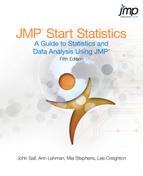 Data Tables, Reports, and Scripts
by Lee Creighton, Mia Stephens, Ann Lehman, Ph.D., John Sall
JMP Start Statistics, 5th Edition
Data Tables, Reports, and Scripts
by Lee Creighton, Mia Stephens, Ann Lehman, Ph.D., John Sall
JMP Start Statistics, 5th Edition
- Preface
- Preliminaries
- JMP Right In
- Data Tables, Reports, and Scripts
- Formula Editor Adventures
- What Are Statistics?
- Simulations
- Univariate Distributions: One Variable, One Sample
- Overview
- Looking at Distributions
- Describing Distributions of Values
- Statistical Inference on the Mean
- Practical Significance vs. Statistical Significance
- Examining for Normality
- Special Topic: Practical Difference
- Special Topic: Simulating the Central Limit Theorem
- Seeing Kernel Density Estimates
- Exercises
- The Difference Between Two Means
- Overview
- Two Independent Groups
- When the Difference Isn’t Significant
- Check the Data
- Launch the Fit Y by X Platform
- Examine the Plot
- Display and Compare the Means
- Inside the Student’s t-Test
- Equal or Unequal Variances?
- One-Sided Version of the Test
- Analysis of Variance and the All-Purpose F-Test
- How Sensitive Is the Test? How Many More Observations Are Needed?
- When the Difference Is Significant
- Normality and Normal Quantile Plots
- Testing Means for Matched Pairs
- Two Extremes of Neglecting the Pairing Situation: A Dramatization
- A Nonparametric Approach
- Exercises
- Comparing Many Means: One-Way Analysis of Variance
- Fitting Curves through Points: Regression
- Categorical Distributions
- Categorical Models
- Overview
- Fitting Categorical Responses to Categorical Factors: Contingency Tables
- Two-Way Tables: Entering Count Data
- If You Have a Perfect Fit
- Special Topic: Correspondence Analysis— Looking at Data with Many Levels
- Continuous Factors with Categorical Responses: Logistic Regression
- Surprise: Simpson's Paradox: Aggregate Data versus Grouped Data
- Generalized Linear Models
- Exercises
- Multiple Regression
- Fitting Linear Models
- Overview
- The General Linear Model
- Kinds of Effects in Linear Models
- Coding Scheme to Fit a One-Way anova as a Linear Model
- Regressor Construction
- Interpretation of Parameters
- Predictions Are the Means
- Parameters and Means
- Analysis of Covariance: Continuous and Categorical Terms in the Same Model
- The Prediction Equation
- The Whole-Model Test and Leverage Plot
- Effect Tests and Leverage Plots
- Least Squares Means
- Lack of Fit
- Separate Slopes: When the Covariate Interacts with a Categorical Effect
- Two-Way Analysis of Variance and Interactions
- Optional Topic: Random Effects and Nested Effects
- Exercises
- Design of Experiments
- Bivariate and Multivariate Relationships
- Exploratory Modeling
- Control Charts and Capability
- Mechanics of Statistics
- Analyze and Graph Menu Commands
- Answers to Selected Exercises
- Chapter 4, "Formula Editor Adventures"
- Chapter 7, "Univariate Distributions: One Variable, One Sample"
- Chapter 8, "The Difference Between Two Means"
- Chapter 9, "Comparing Many Means: One-Way Analysis of Variance"
- Chapter 10, "Fitting Curves through Points: Regression"
- Chapter 11, "Categorical Distributions"
- Chapter 12, "Categorical Models"
- Chapter 13, "Multiple Regression"
- Chapter 14, "Fitting Linear Models"
- Chapter 15, "Design of Experiments"
- Chapter 16, "Bivariate and Multivariate Relationships"
- Chapter 17, "Exploratory Modeling"
- Chapter 18, "Control Charts and Capability"
- References and Data Sources
- Technology License Notices
- Index
3
Data Tables, Reports, and Scripts
Overview
JMP data are organized as rows and columns of a grid referred to as a data table. The columns have names and the rows are numbered. An open data table is kept in memory and displays a data grid with panels of information about the data table. You can open as many data tables in a JMP session as memory allows.
People often ask about the largest data table that JMP can handle. In general, the largest data table JMP should process is one that is about half the size as the actual memory resident in the machine. For example, if a machine has 4 GB of memory, JMP could comfortably manage a data table that is (approximately) 2 GB.
Commands in the File, Edit, Tables, Rows, and Cols menus give you a broad range of data handling operations and file management tasks, such as data entry, data validation, text editing, and extensive table manipulation. The Edit menu contains the Run Script command, used for executing JSL (JMP Scripting Language) scripts.
The Tables menu commands perform a wide variety of data management tasks on JMP data tables. You can also create summary tables for group processing and summary statistics, and dynamically summarize data using Tabulate.
The purpose of this chapter is to tell you about JMP data tables and show hands-on examples to help you get comfortable handling table operations and scripts.
Note: To open the sample data tables used in the examples, use Help > Sample Data. On the Sample data page, click either Open the Sample Data Directory or See an Alphabetical List of all Sample Data Files.
-
No Comment
..................Content has been hidden....................
You can't read the all page of ebook, please click here login for view all page.